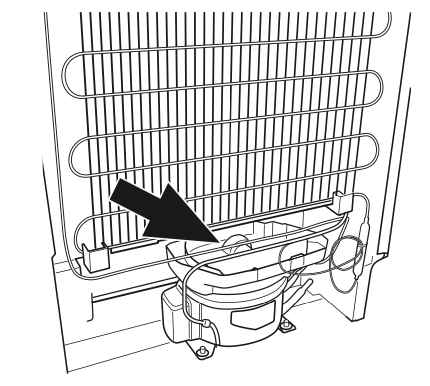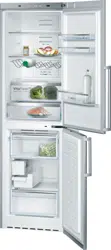Documents: Go to download!
User Manual
- User Manual - (English, French, Spanish)
- Product Specification Sheet - (English)
- Energy Guide - (English)
- Installation Instruction - (English)
- Getting to know your appliance
- Cleaning the appliance
- Light (LED)
- Saving energy
- Operating noises
- Rectifying minor faults yourself
Table of contents
Owner Manual Refrigerator
Getting to know your appliance
These operating instructions refer to several models.
The features of the models may vary. The diagrams may differ.

A Refrigerator compartment
B Freezer compartment
1-8. Operating controls
9. Light switch
10. Light (LED)
11. Air outlet opening
12. Shelves in the refrigerator compartment
13. Bottle shelf
14. Vegetable container
15. Cold storage compartment
16. Freezer drawer
17. Ice maker
18. On/Off switch ice maker
19. Ice cube container
20. Freezer shelf
21. Height-adjustable feet
22. Egg rack
23. Door shelf
24. Bottle holder
25. Shelf for large bottles
26. Active carbon filter
Operating controls
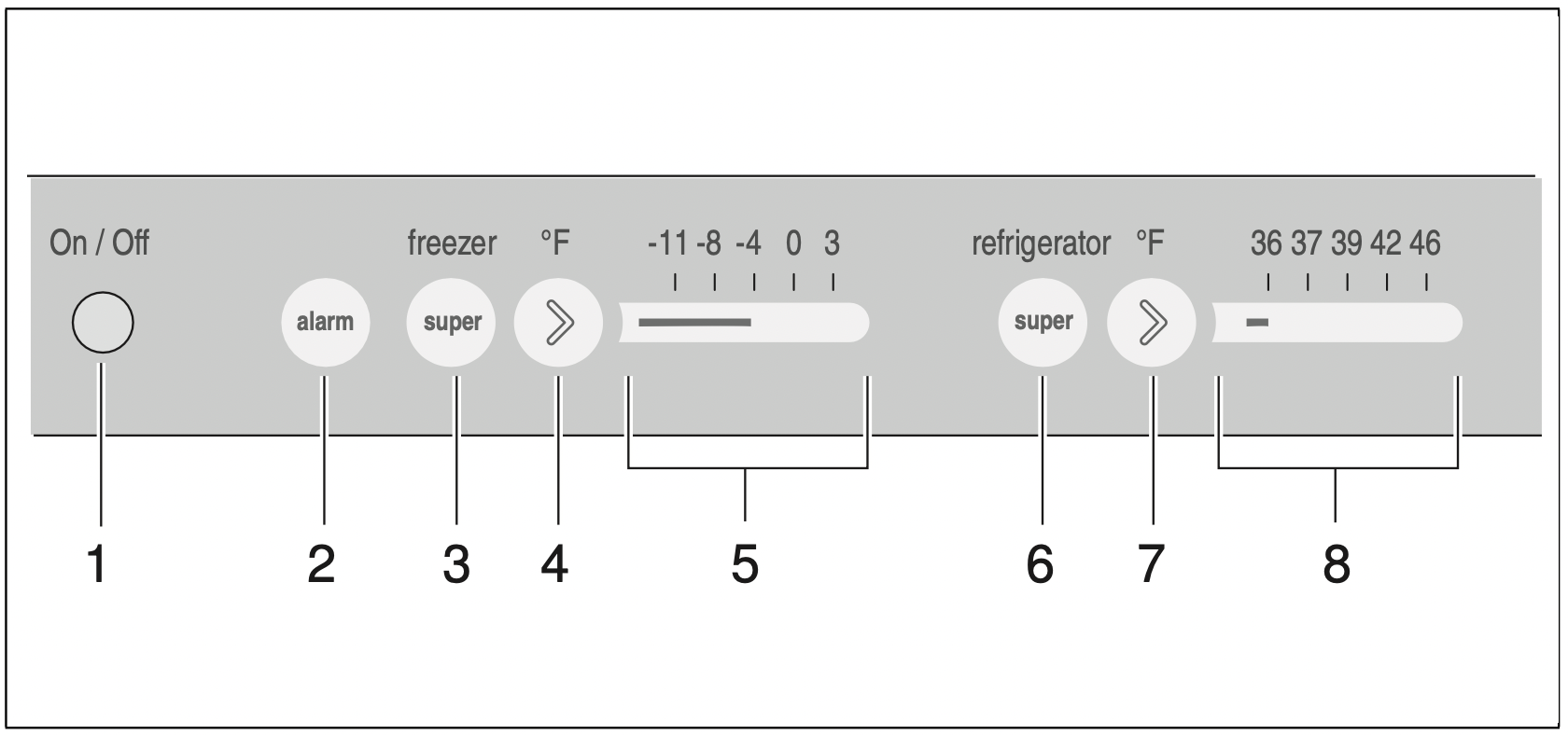
- Button "On/Off"
Serves to switch the whole appliance on and off. - Button "alarm"
Used to switch off the warning signal, see chapter “Alarm function”. - Button "super freezer"
Switches super freezing on and off. - Button "> °F"
The button sets the temperature in the freezer compartment. - Freezer compartment display
Indicates the current temperature setting in the freezer compartment. - Button "super refrigerator"
See other models: SHPM78W55N HBN5651UC HMC87152UC, SHX3AR72UC HCP36E51UC
Switches super cooling on and off. - Button "> °F"
The button sets the temperature in the refrigerator compartment. - Refrigerator compartment display
Indicates the current temperature setting in the refrigerator compartment.
Switching the appliance on
- Switch on the appliance with the button „On/Off“.
A warning signal sounds. Button „alarm“ flashes. - Press the button "alarm". The warning signal switches off.
The button "alarm" remains lit until the set freezer compartment temperature has been reached.
When the door is open, the light in the refrigerator compartment is lit.
Note:
If the light switch is pressed when the door is open, the light and the displays on the controls go out.
The preset temperatures are reached after several hours. Do not put any food in the appliance beforehand.
The factory has recommended the following temperatures:
- Freezer compartment: 0 °F (–18 °C)
- Refrigerator compartment: 39 °F (+4 °C)
Operating tips
- When the appliance has been switched on, it may take several hours until the set temperatures have been reached.
- The fully automatic No Frost system ensures that the freezer compartment remains free of ice. Defrosting is no longer required.
- The sides of the housing are sometimes heated slightly. This prevents condensation in the area of the door seal.
- If the freezer compartment door cannot be immediately re-opened after it has been closed, wait until the resulting low pressure has equalized.
Setting the temperature
Refrigerator compartment
The temperature can be set from 36 °F to 46 °F (+2 °C to +8 °C).
Keep pressing temperature selection button "> °F" until the required refrigerator compartment temperature is set. The value last selected is saved. The set temperature is indicated on the temperature display.
We recommend a factory setting of 39 °F (+4 °C) in the refrigerator compartment.
Perishable food should not be stored above 39 °F (+4 °C).
Freezer compartment
The temperature can be set from 3 °F to -11 °F (-16 °C to -24 °C).
Keep pressing temperature selection button "> °F" until the required freezer compartment temperature is set. The value last selected is saved. The set temperature is indicated on the temperature display.
Energy-saving mode
When the appliance is not used, the display on the controls switches to energy saving mode.
Only the required lamps are lit with reduced luminosity. As soon as the appliance is used, e.g. the door is opened, the display switches back to normal illumination.
Alarm function
In the following cases an alarm may be actuated:
Door alarm
If the appliance is left open for longer than one minute, the door alarm (continuous sound) switches on. Close the door or press the Alarm button 2 to switch the warning signal off again.
Temperature alarm
The temperature alarm switches on if the freezer compartment is too warm and the frozen food is at risk of thawing.
- Alarm button "alarm" flashes: Frozen food is or was at risk of thawing.
- Alarm button "alarm" is lit: Frozen food is not at risk of thawing.
The alarm may switch on without any risk to the frozen food:
- when the appliance is switched on,
- when large quantities of fresh food are placed in the appliance,
- if the freezer compartment door is open too long.
Note: Do not refreeze partly or completely thawed food. Only ready-to-eat meals (boiled or fried) may be refrozen.
Switching off the alarm
Press the alarm button to switch off the warning signal.
Usable capacity
Information on the usable capacity can be found inside your appliance on the rating plate (see diagram in chapter Customer service).
Fully utilizing the freezer volume
To place the maximum amount of food in the freezer, all frozen food containers, except the bottom one, can be taken out of the appliance. The food can be stacked directly on the freezer shelves.
Removing the fittings
Pull out the frozen food containers all the way, lift at the front and remove.
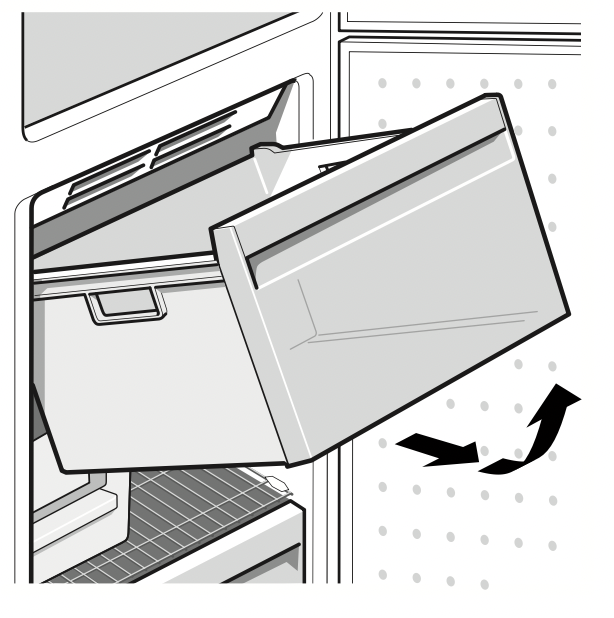
Refrigerator compartment
The refrigerator compartment is the ideal storage location for meat, sausage, fish, dairy products, eggs, ready meals and pastries.
Note when storing food
- Store fresh, undamaged food. The quality and freshness will then be retained for longer.
- In the case of ready-made products and bottled goods, observe the best-before date or use-by date specified by the manufacturer.
- To retain aroma, color and freshness, pack or cover food well before placing in the appliance. This will prevent the transfer of flavors and the discoloration of plastic parts in the refrigerator compartment.
- Allow warm food and drinks to cool down before placing in the appliance.
Note:
Avoid contact between food and rear panel. Otherwise the air circulation will be impaired.
Food or packaging could freeze to the rear panel.
Note the chill zones in the refrigerator compartment
The air circulation in the refrigerator compartment creates different chill zones:
- Coldest zone is on the rear panel inside the appliance and on the cold storage compartment. See chapter Getting to know your appliance.
Note: Store perishable food e.g. fish, sausage, meat in the coldest zones. - Warmest zone is at the very top of the door.
Note: Store e.g. hard cheese and butter in the warmest zone. Cheese can then continue to release its flavor and the butter will still be easy to spread.
Vegetable container with humidity controller
To create the optimum storage climate for fruit and vegetables, you can set the air humidity in the vegetable container depending on the quantity stored:
- smaller quantities of fruit and vegetables – high air humidity
- large quantities of fruit and vegetables – low air humidity
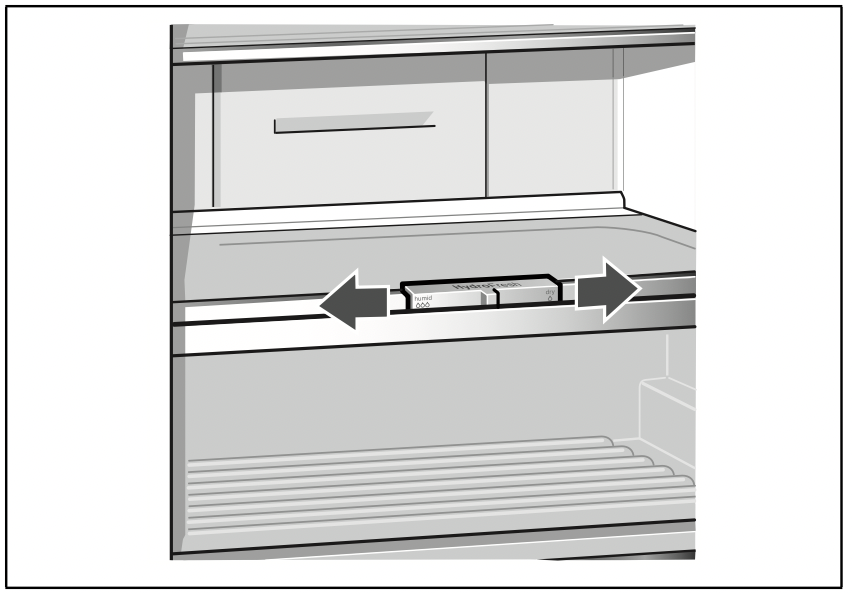
Note:
- Fruit sensitive to cold (e.g. pineapple, banana, papaya and citrus fruit) and vegetables sensitive to cold (e.g. eggplants, cucumbers, zucchini, peppers, tomatoes and potatoes) should be stored outside the refrigerator at temperatures of approx. 46 °F to 54 °F (+8 °C to + 12 °C) for optimum preservation of quality and flavor.
- Condensation may form in the vegetable container depending on the type and quantity of products stored. Remove condensation with a dry cloth and adjust air humidity in the vegetable container with the humidity controller.
Cold storage compartment
See chapter Getting to know your appliance.
The cold storage compartment has lower temperatures than the refrigerator compartment. Even temperatures below 32 °F (0 °C) may occur.
Ideal for storing fish, meat and sausage. Not suitable for lettuce, vegetables and produce sensitive to cold.
Super cooling
Super cooling cools the refrigerator compartment as cold as possible for approx. 6 hours. Then the appliance automatically switches to the temperature set prior to super cooling mode.
Switch on super cooling mode, e.g.:
- before placing large quantities of food in the compartment.
- for the fast cooling of drinks.
Switching on and off
Press button "super refrigerator".
The button is lit when super cooling is switched on.
Freezer compartment
Use the freezer compartment
- To store frozen food.
- To make ice cubes.
- To freeze food.
Note: Ensure that the freezer compartment door has always been closed properly! If the door is open, the frozen food will thaw. The freezer compartment will become covered in thick ice. Besides: energy is wasted due to the high power consumption!
Freezing and storing food
Purchasing frozen food
- The packaging must not be damaged.
- Pay attention to the expiration date.
- Temperature in the supermarket freezer must be 0 °F (–18 °C) or lower.
- If possible, transport frozen food in an insulated bag and place quickly in the freezer compartment.
When loading products
- Preferably freeze large quantities of food in the top compartment, where food freezes particularly quickly and therefore also gently.
- Place the food over the whole area of the compartments or the frozen food containers.
Note: Food which is already frozen must not come into contact with the food which is to be frozen. If required, move the frozen food to other frozen food containers.
Storing frozen food
Insert frozen food container all the way to ensure unrestricted air circulation.
If large quantities of food are to be stored in the freezer, all the frozen food containers (except the bottom one) can be taken out of the appliance and the food stacked directly on the freezer shelves.
To remove a frozen food container, pull out all the way, lift at the front and remove.
Freezing fresh food
Freeze only fresh and undamaged food.
To retain the best possible nutritional value, flavor and color, vegetables should be blanched before freezing. Eggplants, peppers, zucchini and asparagus do not require blanching.
Literature on freezing and blanching can be found in bookstores.
Note: Keep food which is to be frozen away from food which is already frozen.
- The following foods are suitable for freezing:
Baked goods, fish and seafood, meat, game, poultry, vegetables, fruit, herbs, eggs without shells, dairy products such as cheese and butter, ready meals and leftovers such as soups, stews, cooked meat and fish, potato dishes, soufflés and desserts. - The following foods are not suitable for freezing:
Vegetables that are usually consumed raw, such as lettuce or radishes, eggs in shells, grapes, whole apples, pears and peaches, hard-boiled eggs, yoghurt, soured milk, sour cream, crème fraîche and mayonnaise.
Packing frozen food
To prevent food from losing its flavor or drying out, place in airtight containers.
- Place food in packaging.
- Remove air.
- Seal the packaging.
- Label packaging with contents and date of freezing.
Suitable packaging: Cling wrap, tubular film made of polyethylene, aluminum foil, freezer containers.
These products are available from specialist outlets.
Unsuitable packaging: Wrapping paper, greaseproof paper, cellophane, bin liners and used shopping bags.
Items suitable for sealing packaged food: Rubber bands, plastic clips, string, cold-resistant adhesive tape, etc.
Bags and tubular film made of polyethylene (PE) can be sealed with a film heat sealer.
Shelf life of frozen food
Shelf life depends on the type of food. At a temperature of 0° F (–18° C):
- Fish, sausage, ready meals, cakes and pastries: up to 6 months
- Cheese, poultry and meat: up to 8 months
- Vegetables, fruit: up to 12 months
Super freezing
Food should be frozen solid as quickly as possible in order to retain vitamins, nutritional value, appearance and flavor.
Several hours before placing fresh food in the freezer compartment, switch on super freezing to prevent an unwanted temperature rise.
As a rule, 4–6 hours is adequate.
This appliance runs constantly, and the freezer compartment drops to a very low temperature.
Smaller quantities of food (up to 4.4 lbs or 2 kg) can be frozen without “super freezing”.
Note: When super freezing is switched on, increased operating noises may occur.
Note: You can use this function to accelerate the production of ice cubes.
Switching on and off
Press the "super freezer" button.
If super freezing has been switched on, the button is lit. Super freezing switches off automatically after approximately 2½ days.
Thawing frozen food
Depending on the type and application, you can select one of the following options:
- in the refrigerator
- in an electric oven with/without a hot air fan
- in a microwave
CAUTION: Do not refreeze partly or completely thawed food. Only ready-to-eat meals (boiled or fried) may be refrozen.
Ice maker
WARNING: To avoid risk of injury, never reach into the ice cube maker!
Using the ice maker
The ice maker only works when the appliance is connected to the water mains.
When using the ice maker for the first time, do not use the first 30-40 ice cubes for reason of hygiene.
Operating the ice maker
As soon as the freezer compartment has reached its freezing temperature, ice cube production starts. After 2–3 hours the ready ice cubes are automatically discharged into the ice cube container.
Note:
The appliance produces more ice if you lower the freezer compartment temperature. This will slightly increase the energy consumption of your appliance.
Occasionally ice cubes will freeze together.
When the ice cube container is full, ice making switches off automatically.
When ice cubes are being made, the buzzing water valve, the water flowing into the ice cube tray and the falling ice cubes can be heard.
Note:
The fill level gauge in the ice maker (moving metal hook) must not be blocked!
Ice making will otherwise be interrupted.
All materials used in the ice maker are odourless and tasteless.
If the ice has an aftertaste, this may be caused by:
- Mineral and chlorine content of the drinking water.
- Material of the domestic water line or connection line.
- Freshness of the drinking water. If water has not been dispensed for a long time, the water may have a “stale” taste. In this case dispense approximately 3040 ice cubes and throw away.
Switching off the ice maker
If ice cubes are not to be dispensed for longer than 1 week (e.g. holiday), temporarily switch off the ice cube maker to prevent the ice cubes from freezing together.
CAUTION: Before switching off the ice maker, it is imperative that you switch the water supply to the appliance off for a few hours.
- Switch the ice maker on/off button to "0". The ice maker is switched off.
- Remove the ice cube container.
CAUTION: A full ice cube container is heavy! - Empty and clean the ice cube container. Re-insert the container.
Putting back into operation:
- Switch on the water supply again.
- Switch the ice maker on/off button to "I".
Ice cube production restarts.
Note: For reasons of hygiene, do not use the first 30-40 ice cubes.
Interior fittings
(not all models)
Shelves and containers
You can vary the shelves inside the appliance and the containers in the door to suit your requirements. Pull shelf forward, lower and swing out to the side. Lift the container and remove.
Bottle shelf
You can store bottles securely on the bottle shelf. The holder is variable.
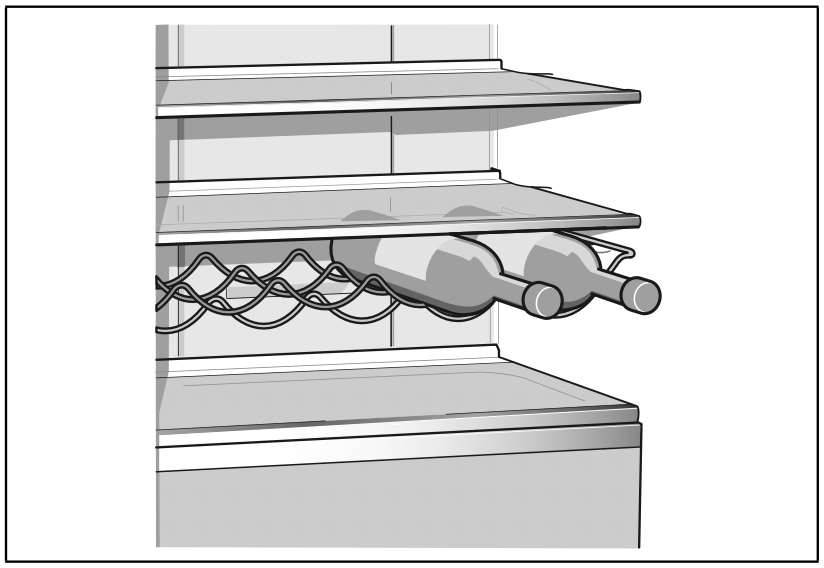
Ice pack
If a power failure or malfunction occurs, the ice packs can be used to slow down the thawing process.
The longest storage time is obtained by placing the ice pack directly on the food in the top compartment.
The ice packs can also be used to cool food temporarily, e.g. in a cold bag.
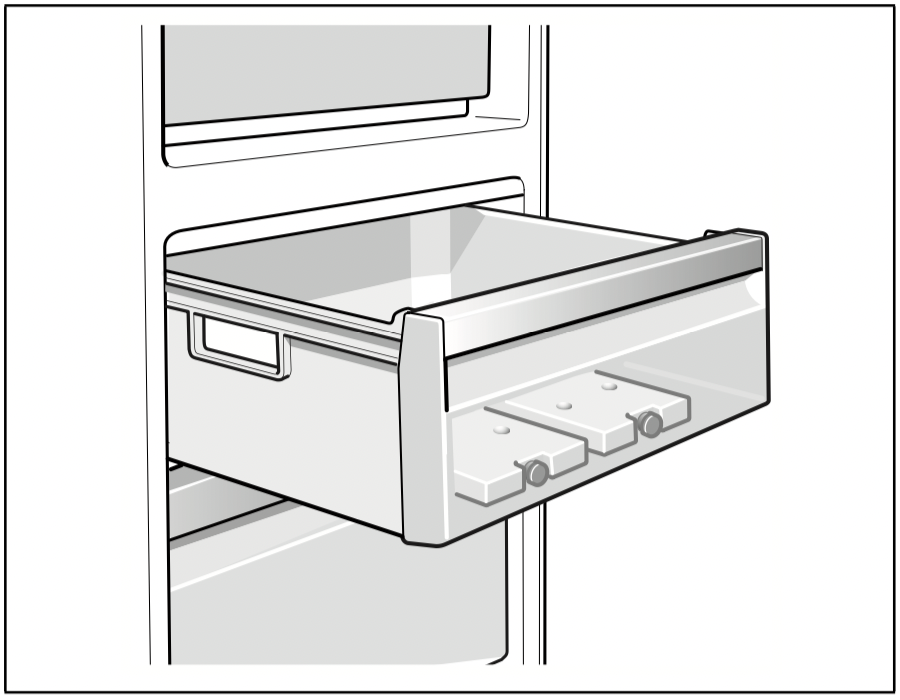
Active carbon filter
The activated carbon filter ensures that air is replaced and odors reduced in the appliance. See chapter “Getting to know your appliance”.
Switching off and disconnecting the appliance
Switching off the appliance
Press the button "On/Off". Refrigeration unit switches off.
Disconnecting the appliance
If you do not use the appliance for a prolonged period:
- Before switching off, it is most important that you switch the water supply to the appliance off for a few hours.
- Take all food out of the appliance.
- Switch the appliance off.
- Pull out mains plug or switch off fuse.
- Empty and clean the ice cube container (see chapter Cleaning the appliance).
- Clean the appliance interior (see chapter Cleaning the appliance).
- Leave the appliance doors open to prevent odours from forming.
Cleaning the appliance
CAUTION:
- Do not use abrasive, chloride or acidic cleaning agents or solvents.
- Do not use scouring or abrasive sponges.
The metallic surfaces could corrode. - Never clean the shelves or containers in the dishwasher.
The parts may become deformed!
Water used for cleaning must not drip into the
- slots in the front base area in the freezer compartment,
- controls,
- and light.
Proceed as follows:
- Before cleaning: Switch the appliance off.
- Pull out power cord plug or switch off fuse.
- Take out the frozen food and store in a cool location.
Place the ice pack (if enclosed) on the food. - Wait until the layer of frost has thawed.
- Clean the appliance with a soft cloth, lukewarm water and a little pH neutral washing-up liquid. The rinsing water must not run into the light.
- Wipe the door seal with clear water only and then wipe dry thoroughly.
- After cleaning reconnect and switch the appliance back on.
- Put the frozen food back in the freezer compartment.
Cleaning external surfaces
The external surfaces of the appliance feature a special dirt-repellent coating. This facilitates cleaning and care.
- Clean external surfaces with a damp cloth only.
CAUTION:
To avoid damaging the special coating:
- Do not use any products which leave a protective film on the surface, e.g. stainless steel care oils.
- Do not use any abrasive implements or detergents, e.g. hard sponges, metal brushes, pointed metallic objects or scouring agents.
- Do not use any aggressive detergents or chemical products, e.g. de-icing sprays, oven cleaner, solvents, chlorine bleach or stain remover.
Interior fittings
All variable parts of the appliance can be taken out for cleaning.
Take out glass shelves
Pull the glass shelves forwards and take out.
Taking out glass shelf above vegetable container
The glass shelf can be taken out and disassembled for cleaning.
Note: Before taking out the glass shelf, pull out vegetable container.
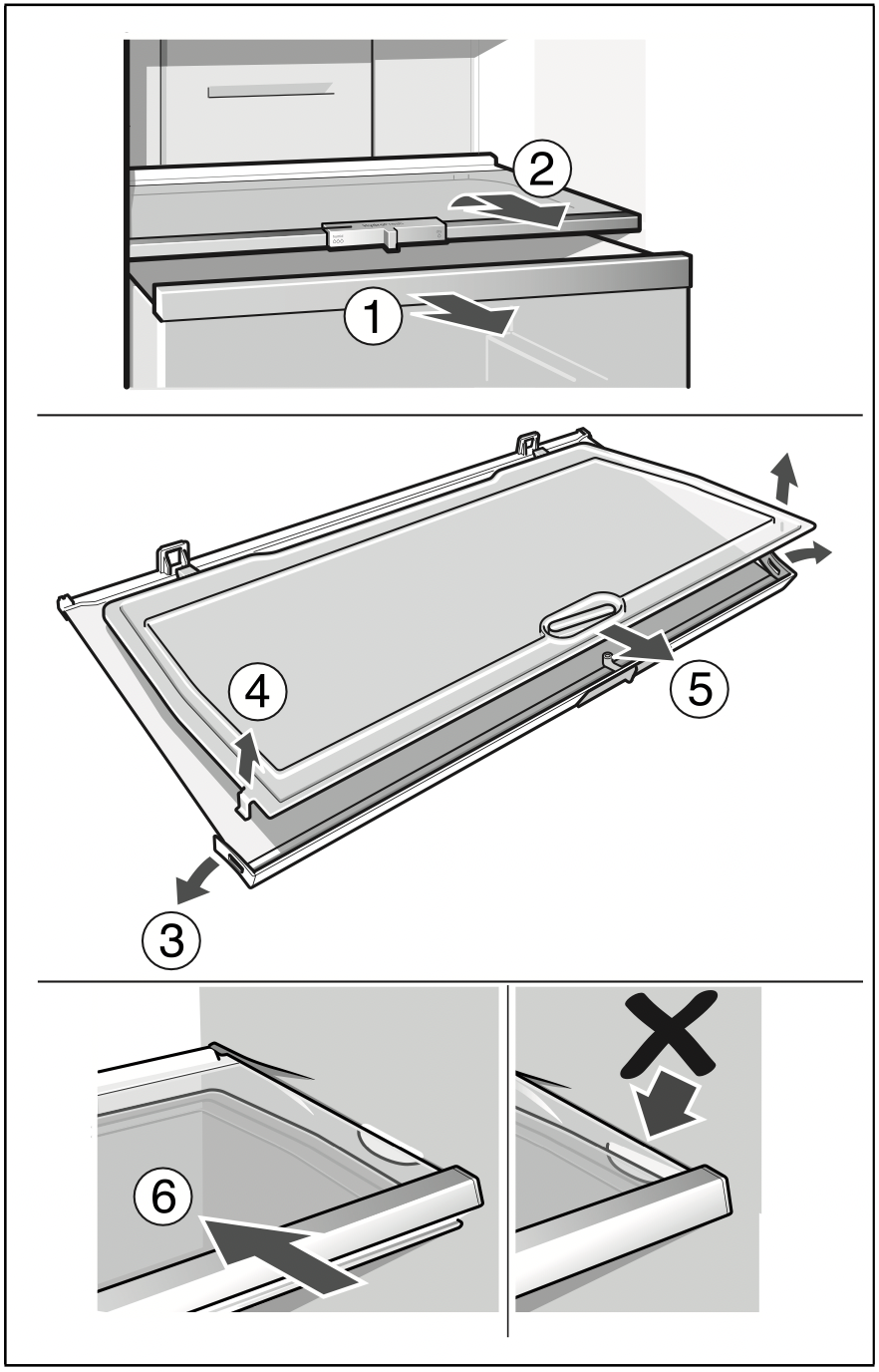
Glass shelf cold storage compartment (not all models)
Note:
Do not clean glass shelf of the cold storage compartment under running water.
Before removing the glass shelf, remove vegetable container and cold storage compartment. Simultaneously press holders, lift glass shelf and pull forward.
Drawers in the refrigerator compartment
Pull out the drawer all the way, lift up and remove.
To insert drawer, place the drawer on the telescopic rails and push into the appliance. Attach the drawer by pressing it down.
Note: Before the vegetable drawer can be taken out, the glass shelf above must be taken out.

Taking out the frozen food container
Pull out the frozen food container all the way, lift at the front and remove.
Cleaning the ice cube container
If ice cubes have not been dispensed for a prolonged period, they will shrink, have a stale taste and stick together. Therefore, the ice cube container should be cleaned regularly.
CAUTION:
A full ice cube container is heavy.
- Switch the ice maker on/off button to "0". The ice maker is switched off.
- Remove the ice cube container.
- Empty the container and clean with lukewarm water.
- Thoroughly dry the container to prevent new ice cubes from sticking.
- Insert the ice cube container.
Ice cube production continues. - Switch the ice maker on/off button to "I".
Ice cube production restarts.
Light (LED)
Your appliance features a maintenance-free LED light. These lights may be repaired by customer service or authorized technicians only.
Saving energy
- Install the appliance in a dry, ventilated room. The appliance should not be installed in direct sunlight or in the vicinity of heat sources (e.g. radiator, cooker). If required, use an insulating plate.
- Allow warm food and drinks to cool down before placing them in the appliance.
- Thaw frozen food in the refrigerator compartment and use the low temperature of the frozen food to cool refrigerated food.
- Open the appliance as briefly as possible.
- To avoid increased power consumption, occasionally clean the back of the appliance.
- If available:
Fit wall spacers to obtain the indicated energy absorption of the appliance (see Installation instructions). A reduced wall gap will not restrict the function of the appliance. The energy rating may then increase slightly. - The arrangement of the fittings does not affect the energy absorption of the appliance.
Operating noises
Completely normal noises
Droning
Motors are running (e.g. refrigeration units, fan).
Bubbling, humming or gurgling noises
Refrigerant is flowing through the tubing or water is flowing into the ice maker.
Clicking
Motor, switches or solenoid valves are switching on/off. Rumbling Ready ice cubes from the ice maker are falling into the ice cube container.
Preventing noises
The appliance is not level
Please align the appliance with a spirit level. Use the height-adjustable feet or place packing underneath them.
The appliance is not free-standing
Please move the appliance away from adjacent units or appliances.
Containers or storage areas wobble or stick
Check which parts are removable and, if necessary, reinsert them correctly.
Bottles or receptacles are touching each other
Move the bottles or receptacles slightly away from each other.
Rectifying minor faults yourself
Before you call customer service:
Check whether you can eliminate the fault yourself based on the following information.
Otherwise, you may be charged for a service repair as it would not be covered by the warranty.
| Fault | Possible cause |
Remedial action |
|---|---|---|
| Temperature differs greatly from the set value. |
In certain cases it may be enough to switch off the appliance for 5 minutes. If the temperature is too high, wait a few hours and check whether the temperature has approached the set value. If the temperature is too low, check the temperature again the next day. |
|
| The light does not work. |
Light switch is jammed. |
Check whether the light switch can move. |
| The light is defective. |
(See chapter “Light”.) |
|
| Controls have reduced luminosity. | When the appliance is not used for some time, the display on the fascia switches to energy saving mode. |
As soon as the appliance is again used, e.g. the door is opened, the display switches back to normal illumination. |
| Displays do not illuminate. | Power cut; the fuse has tripped; the mains plug has not been inserted properly. |
Connect the mains plug. Check whether the power is on, and check the fuses. |
| The temperature in the freezer compartment is too warm. | Appliance opened frequently. |
Do not open the appliance unnecessarily. |
| The ventilation openings have been covered. |
Remove obstacles. |
|
| Large quantities of fresh food are being frozen. |
Freeze less fresh food. |
|
| Freezer compartment door was open for a long time; temperature is no longer reached. | The evaporator (refrigeration unit) in the NoFrost system is covered in thick ice and can no longer be automatically defrosted. |
To defrost the evaporator, remove the frozen food with the compartments, insulate it well and store it in a cool location. Switch off the appliance and move it away from the wall. Leave the appliance door open. After approximately 20 minutes, the melted water begins to run into the evaporation pan at the rear of the appliance.
To keep the evaporation pan from overflowing, mop up the condensation with a sponge. CAUTION: RISK OF BURNS: Parts may be hot. Proceed with caution. The evaporator is defrosted when no more water is running into the evaporation pan. Clean the interior. Switch the appliance back on. |
Ice maker
| Fault | Possible cause |
Remedial action |
|---|---|---|
| The ice maker doesn’t work. | Ice maker is not connected to the mains supply. |
Call customer service. |
| Ice maker does not contain any fresh water. |
Ensure that the water is properly connected. |
|
| The freezer compartment temperature is too warm. |
Check freezer compartment temperature and, if required, set slightly colder. |
|
| The ice maker doesn't work. | The water supply is switched off. |
Turn the water supply on. |
| The ice maker is switched off |
Switch on the ice maker. |
|
| The fill level gauge (metal hook) is blocked. |
Remove the blockage. |
|
|
Ice cubes are watery. Ice cubes have melted. |
Remove the ice cube container, empty and rub dry. |
|
| Freezer compartment door is open. |
Close the door. |
|
| Power failure. |
Check whether the power is on. |
|
|
Ice cubes in the ice cube container stick together. |
Normal behavior for longer storage periods. |
Remove the ice cubes. |
| The ice cubes are too small. | Water pressure too low. |
Ensure the minimum pressure of 29 psi (2 bar). |
